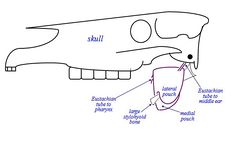Guttural Pouches - Anatomy & Physiology
Also known as: Auditory Tube Diverticulum
Introduction
The Guttural Pouch is present only in members of the order Perissodactyla (nonruminant ungulates: horses, tapirs, rhinoceros) and another small band of small mammals including Hyraxes, certain bats and a South American mouse.
The guttural pouches are paired ventral diverticulae of the eustachian (auditory) tubes, formed by escape of mucosal lining of the tube through a relatively long ventral slit in the supporting cartilages. The auditory tube connect the nasal cavity and middle ear and the diverticulum dilates to form pouches which can have a capacity of 300-500ml in the domestic horse. The pouches are normally air filled.
Structure
The Guttural Pouch is located below the cranial cavity, towards the caudal end of the skull/wing of atlas. It is covered laterally by the Pterygoid muscles, parotid and mandibular glands. The floor lies mainly on the pharynx and beginning of the Oesophagus. The medial retropharyngeal lymph node lies between the pharynx and ventral wall of the pouches.
Right and left pouches are separated dorsomedially by rectus capitis ventralis and longus capitis muscles. Below this, by fused walls of the two pouches, the median septum is formed.
Each pouch is moulded to the stylohyoid bone which divides the medial and lateral compartments, the medial compartment being approximately double the size of the lateral one and extends further caudally and ventrally.
The guttural pouch has close association with many major structures including several cranial nerves (glossopharyngeal, vagus, accessory, hypoglossal), the sympathetic trunk and the external and internal carotid arteries. The pouch directly covers the temporohyoid joint. The pouch has an extremely thin wall which is lined by respiratory epithelium which secretes mucus. This normally drains into the pharynx when the horse is grazing.
Several cranial nerves and arteries lie directly against the pouch as they pass to and from foramina in the caudal part of the skull (vessels within mucosal folds that indent the pouches):
Medial Compartment:
- Cranial nerves IX, X, XI, XII.
- Continuation of the sympathetic trunk beyond the cranial cervical ganglion.
- Internal carotid artery.
Lateral Compartment:
- Cranial nerve VII - limited contact with the dorsal part of the compartment.
- External carotid artery crosses the lateral wall of the lateral compartment in its approach (as maxillary artery) to the atlas canal. The external maxillary vein is also visible.
Drainage:
Natural drainage of the pouch is throught the slit-like (pharyngeal) openings of the eustachian tube in the lateral wall of the nasopharynx. The connection opens when the horse swallows and grazing normally provides drainage. However, most of the pouch is ventral to his slit, and therefore drainage may be rather ineffective. If blocked, secretions accumulate and the pouch distends producing a palpable swelling.
Function
The function of the guttural pouches has been shown with experimental data to participate in the rapid cooling of arterial blood destined for the brain and surrounding structures. In other words, the horse's guttural pouches are 'brain-cooling devices', cooling blood within the internal carotid arteries during hyperthermia that occurs during heavy exercise.[1][2] However, this proven function has been called into question by another study that neither examined the guttural pouches nor the internal carotid arteries;[3] and others have argued that a cooling function would require an unattainable high rate of inspiratory air flow partly diverted into the guttural pouches.[4]
The issue of necessary guttural pouch air flow rates, to provide rapid cooling of the internal carotid arteries, has been solved by further supporting evidence from microvascular studies of the guttural pouch mucosa.[5] Many of the guttural pouch mucosal superficial arterioles and capillaries extend outwards, forming two types of vascular plexuses surrounding the internal carotid arteries: one with capillary bundles parallel to the internal carotid arteries in the outer layer of the tunica adventitia (outer peri-arterial plexus) and the other with vein-artery-vein triads within the inner layer of the tunica adventitia (inner peri-arterial plexus). These guttural pouch microvascular plexuses, engulfing the internal carotid arteries, are typical of countercurrent heat exchangers recognised in other animal species, supporting the data that guttural pouches participate in selective brain cooling, even at lower air flow rates.
This completes the triad of internal carotid artery cooling that protects the horse's brain from hyperthermia. The triad including the function of guttural pouches achieving arterial cooling, via both by utilizing inspiratory air cooling as well as microvascular countercurrent heat exchangers surrounding internal carotid arteries, and finally afterwards where the internal carotid arteries project upwards passing through the intracranial cavernous venous sinuses accepting cooled venous blood from the nasal sinuses.[6]
Links
References
Dyce, K.M., Sack, W.O. and Wensing, C.J.G. (2002) Textbook of Veterinary Anatomy. 3rd ed. Philadelphia: Saunders.
- ↑ {{#invoke:Citation/CS1|citation |CitationClass=journal }}
- ↑ {{#invoke:Citation/CS1|citation |CitationClass=journal }}
- ↑ {{#invoke:Citation/CS1|citation |CitationClass=journal }}
- ↑ {{#invoke:Citation/CS1|citation |CitationClass=journal }}
- ↑ {{#invoke:Citation/CS1|citation |CitationClass=journal }}
- ↑ {{#invoke:Citation/CS1|citation |CitationClass=journal }}
